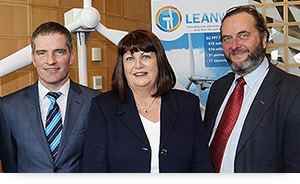FOREWORD
Message from the coordinator, Jimmy Murphy, HMRC, University College Cork, Ireland
The LEANWIND project began in December 2013. Achieving cost reductions for the offshore wind industry is an ambition being pursued by many but in our consortium we have the range of expertise, spanning a number of different sectors, that will ensure that we will make a worthwhile contribution to this goal.
 |
|
Kick-off meeting, 10-11 December 2013, Dublin
Former EU Commissioner for Research, Innovation & Science, Máire Geoghegan-Quinn (centre) with the LEANWIND management team, Dr. Jimmy Murphy of Beaufort Research, University College Cork (left) and Ørnulf Jan Rødseth of the Norwegian Marine Technology Research Institute (right). © Gary O'Neill (photographer)
|
Early work was primarily of a planning nature to allow us to define exactly the tasks ahead and a number of the early deliverables outlining this process will soon be made public. However, the real work of the project has begun in earnest and in later editions of this newsletter we will report real progress in terms of design and system innovations. All the best,
Jimmy Murphy
|
WHAT IS LEANWIND ABOUT?
LEANWIND is a four-year project co-funded by the Seventh Framework Programme of the European Union. It will bring cost reductions to the offshore wind energy industry through the application of lean principles to key aspects of an offshore wind farm and supply chain. It will do so by focusing on developing innovative technologies, procedures and tools that are directly applicable and beneficial to the industry in the short to medium term.
For more information, please visit: www.leanwind.eu
|
PROGRESS & RESULTS
LEANWIND has already produced some important results:
This report provides a historical overview of the foundation types currently used, and introduces emerging and developing concepts in an attempt to outline the current status and prospective future trends in the industry to envisage realistic design scenarios. It serves as the basis upon which to build the entire scope of work of WP2.
Read the full report!
The wind farm installation phase requires a number of vessel types. While many do not necessarily require technological innovation to be effective for the industry, the increasing installation volumes, turbine size, water depth and distance from shore means that the anticipated shortage of supply can be fulfilled by vessels developed considering cost efficiencies for the industry. Confidence in terms of financial support for offshore wind and future substructure design would encourage their construction.
Read the full report!
This document outlines the main challenges for operation and maintenance of offshore wind farms. The following key areas are covered:
- Technical integrity
- Operational integrity
- Tools and methodologies
- Standardization
- Lifetime extension
- Climate change
Read the full report!
The final cost of energy produced by off-shore wind farms can be reduced by rendering the whole logistics system more efficient throughout the wind farm supply chain lifecycle – from installation and O&M to the decommissioning phase. The use of lean principles will help in defining the key industry challenges, analysing the separate parts composing the offshore wind supply chain – such as on-land transport and ports- and optimising them. Read the full report!
|
INDUSTRY INVOLVEMENT
The project envisages high industry participation and will result in the creation of jobs and new markets in Europe. An Industry Advisory Group (IAG) will be constantly informed about the project's progress and be able to give advice throughout the whole project lifecycle. The first IAG physical meeting occurred during the Kick-off meeting (first General Assembly) in December, 2013, while the second one took place in Hull on November 21st, 2014. |